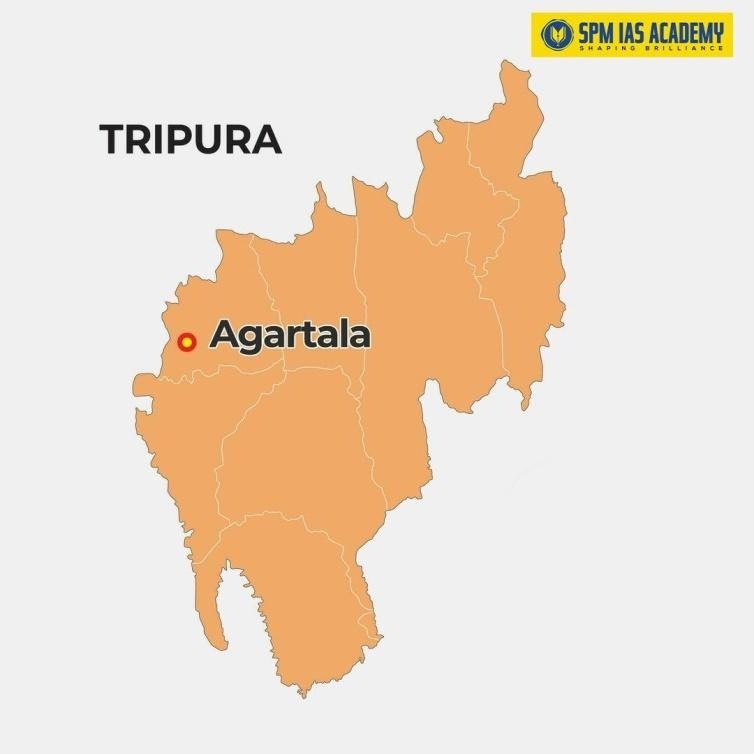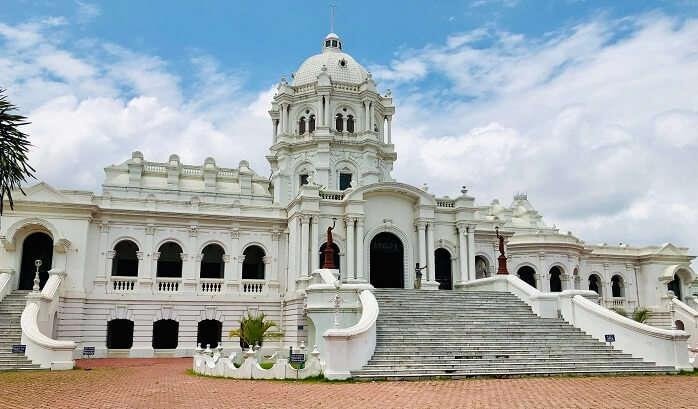Tripura, one of the eight states of Northeast India, is known for its rich cultural heritage, scenic landscapes, and historical significance. The capital of Tripura is Agartala, a vibrant city that reflects the blend of traditional tribal culture and modern development. However, located on the banks of the Haora/Saidra River and just a few kilometers from the Bangladesh border, Agartala, as the capital of Tripura, serves as the political, economic, and cultural heart of the state. Further, the city beautifully blends ancient traditions with modern progress, making it a unique destination for travelers and scholars alike.

Etymology and Historical Background of Agartala, the Capital of Tripura:
- The name Agartala is derived from two words — “agar” and “tala.”
- “Agar” refers to a valuable perfume and incense tree belonging to the Aquilaria genus.
- Together with, the suffix “tala” means “underneath,” signifying the region’s dense growth of agarwood trees.
- According to legend, King Raghu once tied his elephant’s feet to an agar tree on the banks of the River Lauhitya, highlighting the tree’s historical significance in the area.
Early History of Agartala:
- Moreover, Agartala is also referenced in the Indian epic Mahabharata, highlighting its ancient significance.
- One of the earliest known kings of Agartala was Patardan, who ruled around 1900 BC, marking the prehistoric era of the city.
- Chitrarath, Drikpati, Dharmapha, and Loknath Jivandharan were other prominent rulers who contributed to the growth of ancient Agartala.
- This glorious period preceded the rise of the Manikya Dynasty, which later shaped the medieval history of Tripura.
Medieval History of Agartala:
- The medieval history of Agartala reflects the glorious reign of Maharaja Bir Bikram Kishore Manikya Bahadur, one of Tripura’s most ambitious and visionary rulers.
- Under his rule, Tripura flourished as an independent Northeastern state, achieving significant progress in administration and urban development.
- However, Maharaja Bir Bikram Kishore Manikya Bahadur is the creator of the planned city of Agartala.
- After his visit to the United Kingdom, he decided to transform Agartala into a “mini United Kingdom.”
- In the medieval era, the region was ruled by around 179 Hindu kings, beginning with the mythological King Druhya and continuing until the reign of Kirit Bikram Kishore Manikya, the last ruler of Tripura.
- Besides Hindu rule, Tripura also came under the influence of the Mughal Empire, reflecting its dynamic historical transitions.
- In 1760, Maharaja Krishna Chandra Manikya Bahadur of the Manikya Dynasty shifted the capital from Rangamati to the present-day old capital of Tripura, Agartala, located on the banks of the Haora-Saidra River, and named it “Haveli.”
Modern History of Agartala:
- Coupled with the rise of British colonial rule in India, Tripura came under the governance of the British Government in 1808.
- The ancient capital of the princely state “Swadhin Tripura” was Rangamati (now known as Udaipur in South Tripura), situated on the banks of the Gomati River.
- Furthermore, to avoid frequent Kuki invasions and to maintain better communication with the British Government in Bengal, Maharaja Krishna Chandra Manikya shifted the capital from Old Haveli to New Haveli (present-day Agartala) in 1849.
- After the end of the British East India Company’s rule, the British Government of India continued to communicate directly with the Raja of Tripura.
- During that time, Agartala served as the capital of the erstwhile “Hill Tippera” state.Further, it officially became a municipality between 1874 and 1975.
- In 1901, Agartala had a population of about 9,513, reflecting its gradual urban growth under princely administration.
- In addition, the princely state of Tripura often attracted the interest of the British and other invaders, being viewed as a strategic region in Northeast India.
- During one such invasion, Arakan soldiers attacked the old capital, but the King of Tripura cleverly countered their assault, ultimately defeating the entire troop through strategic warfare.
Agartala in Post Independent India:
- When India gained independence in 1947, the people of Tripura launched the Ganamukti Parishad movement to ensure the state’s integration with the Indian Union.
- The Queen of Tripura, Maharani Kanchanprava Devi signed the merger agreement on 15th October 1949 to join independent India.
- Subsequently, on 1st July 1963, Tripura became a centrally administered Union Territory.
- Later, on 21st January 1972, Tripura achieved full statehood, and Agartala became the capital of Tripura.
Geographical Features of Agartala, the Capital of Tripura:
- Agartala is located on a plain land along the Haora River, while its northern parts extend into low-lying hills, giving the city a varied landscape.
- The city experiences a monsoon-influenced humid subtropical climate (Köppen Cwa), which is almost tropical in nature.
- Throughout the year, Agartala receives substantial rainfall, except during the short dry “winter” or “cool” season.
- The city witnesses long, hot, and wet summers that extend from April to October.
- Average temperatures remain around 28°C (82.4°F) during this period, though they fluctuate with changing rainfall patterns.
- From mid-November to early March, Agartala enjoys a short and mild winter, characterized by dry weather and average temperatures near 18°C (64°F).
- Heavy rains often cause flooding, especially during the monsoon months.
Demography:
- As of the 2011 Indian Census, the population in Agartala is 400,004. Of which 200,132 were males and 199,872 were females.
- The population within the age range of 0 to 6 year is 35,034.
- The total number of literates in Agartala was 344,711, which constituted 86.18% of the population with male literacy of 87.53% and female literacy of 84.82%.
- The effective literacy rate of 7+ population of Agartala was 94.5%, of which male literacy rate was 96.2% and female literacy rate was 92.8%.
- The sex ratio of Agartala is 999 females per 1,000 males.
- The Scheduled Castes and Scheduled Tribes are 77,663 and 19,767 respectively.
Language:
- Bengali, the official state language, is the dominant language in Agartala spoken by 90.84% of the population.
- English is also a popular language in the state.
- Kokborok, another official language, is spoken by 4.05% in the city.
- Hindi and Meitei are spoken by 2.36% and 0.83%, respectively.
Administrative Importance:
Agartala houses the key offices of the Government of Tripura, including:
- Tripura Legislative Assembly
- Raj Bhavan (Governor’s Residence)
- Chief Minister’s Office and Secretariat
- High Court of Tripura
- It is also the headquarters of the Agartala Municipal Corporation and serves as the main hub for government, education, and healthcare services.
Cultural and Educational Significance:
- Being the capital of Tripura, Agartala represents a mix of tribal and Bengali culture. The city celebrates various festivals such as:
- Durga Puja
- Kharchi Puja
- Garia Puja
- Pous Sankranti
- The people of Agartala speak Bengali, Kokborok, and English, reflecting the state’s linguistic diversity.
- Major educational institutions include:
- Tripura University (Central University)
- National Institute of Technology (NIT), Agartala
- Tripura Medical College
- ICFAI University, Tripura
These institutions have made Agartala an emerging education hub of Northeast India.
Tourism in Agartala:

Besides being the capital of Tripura, Agartala offers a variety of attractions for tourists and history enthusiasts alike.
Top tourist places include:
- Ujjayanta Palace: A magnificent royal palace built by Maharaja Radha Kishore Manikya in 1901.
- The Tripurasundari Temple, one of the 51 Shakti Peethas, attracts thousands of pilgrims each year with its religious significance and serene surroundings.
- Neermahal: Known as the “Lake Palace of Tripura,” located in Melaghar, about 53 km from Agartala.
- Tripura State Museum: Showcases tribal artifacts, crafts, and royal memorabilia.
- Heritage Park and Nehru Park: Highlights Tripura’s cultural and architectural diversity.
- The State Museum, Rabindra Kanan, and Sukanta Academy provide rich insights into Tripura’s literature, art, and traditions.
- Jagannath Temple & Ummaneshwar Temple: Famous for their spiritual and architectural beauty.
Connectivity in Agartala:
Being the capital of Tripura, it is necessary for Agartala to have better connectivity with other parts of the country.
- Air connectivity: Maharaja Bir Bikram (MBB) Airport is the Tripura’s main international airport.
- Railways: Connected to major cities like Guwahati, Kolkata, and Silchar.
- Road connectivity: National Highway 8 links Agartala to the rest of India through Assam.
- The city is also connected to Bangladesh through the Integrated Check Post (ICP) at Akhaura, promoting trade and tourism between the two nations.
- Besides, Agartala has a crucial role to play in the Kaladan Multi-Modal Transit Transport Project.
Conclusion:
In conclusion, Agartala stands as a vibrant reflection of Tripura’s rich history, culture, and modern growth. The city beautifully blends its royal legacy with rapid urban development, making it a vital hub of administration, education, and trade in Northeast India. Over the years, Agartala has evolved from a princely capital to a well-planned modern city, showcasing the vision of its former rulers and the spirit of its people.
Moreover, its strategic location along the Haora River and close proximity to Bangladesh enhance its cultural and economic significance. With its heritage monuments, pleasant climate, and welcoming atmosphere, Agartala continues to attract tourists, historians, and learners. Thus, the capital of Tripura not only preserves the essence of the state’s glorious past but also paves the way for a progressive future rooted in harmony and tradition.
Sources:
- https://en.wikipedia.org/wiki/Agartala
- https://www.indianetzone.com/history_agartala
- https://ica.tripura.gov.in/
Article List
Latest Articles
| Article Title | Read More |
|---|---|
| Top 10 UNESCO World Heritage Sites in India | Read Article |
| Special Agencies of United Nations | Read Article |
| Tiger Reserves in India | Read Article |
| Neighboring Countries of India | Read Article |
| Middle East Countries | Read Article |
| Top 10 Highest Mountain Peaks in India | Read Article |
| 10 Most Powerful Countries in the World by Military Strength | Read Article |
Agartala, the capital of Tripura is famous for its royal heritage, especially the Ujjayanta Palace, vibrant Tripuri culture, and scenic natural beauty. It is also known as the gateway to Tripura and a growing hub for trade and tourism in Northeast India.
Agartala officially became the capital of Tripura in 1972, when the state attained full-fledged statehood on 21st January 1972.
The Haora River flows through Agartala, adding to the city’s charm and playing a key role in its geography and local ecosystem.
Major attractions in Agartala include the Ujjayanta Palace, Tripurasundari Temple, Heritage Park, Nehru Park, and State Museum, showcasing the city’s history and culture.
Being the capital of Tripura, Agartala serves as the economic, political, and administrative hub of Tripura. It drives growth through trade, education, tourism, and cross-border connectivity with Bangladesh.












